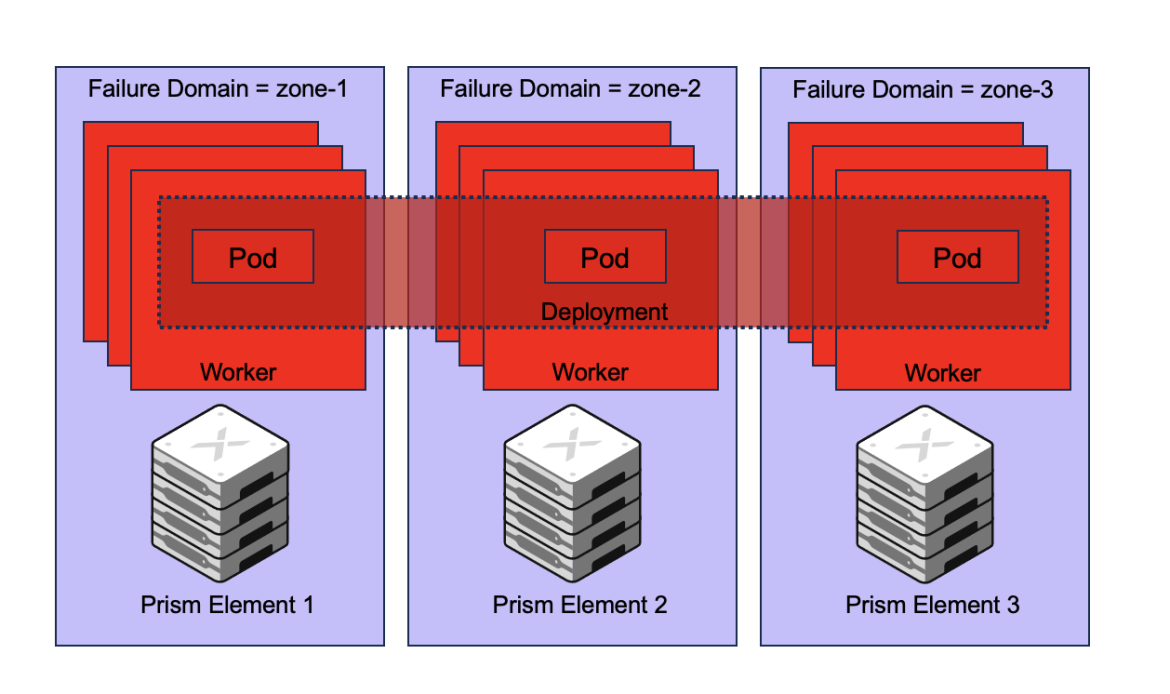This post was written with the help of Yannick Struyf, Senior Product Manager Cloud Native at Nutanix.
Unplanned interruptions of applications results in time and financial losses for your organization, along with the challenge of restoring normal operations.
The Red Hat OpenShift 4.15 release used on the Nutanix Cloud Platform now enables you to increase the resiliency of your OpenShift cluster and ensure the continuous operation of your applications during a disaster. Keep reading to discover how the Failure Domain feature elevates your OpenShift deployment on Nutanix infrastructure.
Distribute OpenShift nodes across Nutanix Prism Element clusters
Achieving fault-tolerant deployments is now possible with the utilization of multiple Prism Element clusters in the Nutanix environment, which are Nutanix logical entities that act as failure domains.
By strategically distributing the control plane and compute nodes across multiple Prism Element clusters, you can improve the high availability of your OpenShift environment. This multicluster (as in multiple Prism Element clusters) approach ensures that if a failure occurs in one domain, the remaining Prism Element instances continue to provide support to the OpenShift machine pools.
All of this is possible during and after the installation of OpenShift. This architectural resilience safeguards your system against potential disruptions and fosters a more robust and reliable infrastructure for your OpenShift deployment.
Let’s see this graphically:

The above diagram shows an OpenShift cluster with failure domains for the OpenShift nodes across three Prism Element clusters.
Adding the configuration
To distribute the control plane and compute nodes across Prism Element clusters at the time of installation, the installer is instructed to do so in the install-config.yaml file:
platform:
nutanix:
failureDomains:
- name: failure-domain-1
prismElement:
uuid: ed4e151b-4e8d-4567-a4ee-7500ea4ed50b
subnetUUIDs:
- 8db8a556-7e36-446f-aa2d-ec10915b11c8
- name: failure-domain-2
prismElement:
uuid: 88b721c0-a791-47bd-a03c-ab509de45b57
subnetUUIDs:
- 964b3373-a7a7-4dc8-a1b0-ebd03b8d8253
- name: failure-domain-3
prismElement:
uuid: 17f15783-d4d9-4b7d-8efc-5d4f51b9b83c
subnetUUIDs:
- 850f08f7-0aa2-48af-9243-9efbad0b8a6b
- name: failure-domain-4
prismElement:
uuid: ed4e151b-4e8d-4567-a4ee-7500ea4ed50b
subnetUUIDs:
- e19a2161-7ced-4865-9126-51d514172dc3
- name: failure-domain-5
prismElement:
uuid: d3451043-fb0a-4e71-979f-6a23f9b9c2e3
subnetUUIDs:
- f342e8be-267a-4855-8e60-274a1978341e
controlPlane:
nutanix:
failureDomains:
- failure-domain-1
- failure-domain-2
- failure-domain-3
compute:
nutanix:
failureDomains:
- failure-domain-3
- failure-domain-4
- failure-domain-5The example shows five failure domains, each mapping to a different Prism Element cluster.
The first three failure domains each host one of the three control plane nodes. Note that the control plane nodes must be on the same subnet so they each have the same CIDR in Prism Element, for example 192.168.1.0/24.
Failure domains 3-5 host the compute nodes. These failure domains can have different CIDRs, providing extra flexibility for the user to install a Nutanix cluster and place compute nodes on different subnets.
In Summary
The Failure Domain feature on the Nutanix Cloud Platform helps to increase the resiliency of your Openshift clusters. To learn more about the details and to start using it right away read the official documentation for install-time configuration and post-installation configuration.
About the author
More like this
Browse by channel
Automation
The latest on IT automation that spans tech, teams, and environments
Artificial intelligence
Explore the platforms and partners building a faster path for AI
Open hybrid cloud
Explore how we build a more flexible future with hybrid cloud
Security
Explore how we reduce risks across environments and technologies
Edge computing
Updates on the solutions that simplify infrastructure at the edge
Infrastructure
Stay up to date on the world’s leading enterprise Linux platform
Applications
The latest on our solutions to the toughest application challenges
Original shows
Entertaining stories from the makers and leaders in enterprise tech
Products
- Red Hat Enterprise Linux
- Red Hat OpenShift
- Red Hat Ansible Automation Platform
- Cloud services
- See all products
Tools
- Training and certification
- My account
- Developer resources
- Customer support
- Red Hat value calculator
- Red Hat Ecosystem Catalog
- Find a partner
Try, buy, & sell
Communicate
About Red Hat
We’re the world’s leading provider of enterprise open source solutions—including Linux, cloud, container, and Kubernetes. We deliver hardened solutions that make it easier for enterprises to work across platforms and environments, from the core datacenter to the network edge.
Select a language
Red Hat legal and privacy links
- About Red Hat
- Jobs
- Events
- Locations
- Contact Red Hat
- Red Hat Blog
- Diversity, equity, and inclusion
- Cool Stuff Store
- Red Hat Summit

